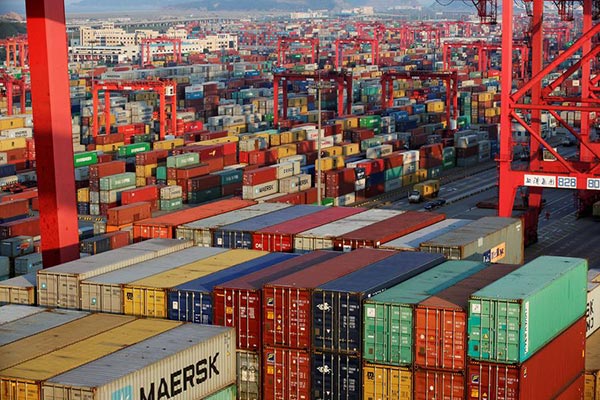Q3 trade growth rebounds, pressure remains
Updated: 2016-10-13 11:31
(Xinhua)
|
|||||||||
 |
|
Container boxes are seen at the Yangshan Deep Water Port, part of the Shanghai Free Trade Zone, in Shanghai, September 24, 2016. [Photo/Agencies] |
BEIJING - China's trade growth rebounded in the third quarter of this year thanks to policy support and a stabilizing economy, but is still facing complex domestic and global challenges.
Foreign trade in the first three quarters was down 1.9 percent from a year earlier to reach 17.53 trillion yuan ($2.61 trillion), with exports dropping 1.6 percent and imports falling 2.3 percent,according to figures from the General Administration of Customs (GAC) on Thursday.
In breakdown, Q3 trade showed signs of stabilization with exports and imports gaining growth of 0.4 percent and 2.1 percent, while those in the previous two quarters both recorded falls.
China's trade slowdown appears to be bottoming out, said Huang Songping, spokesperson with GAC, citing the effects of previous supportive policies, improving market sentiment and rising imports demands thanks to growing economic activities.
Foreign trade with countries included in the China-proposed Belt and Road initiative posted strong growth momentum during the January-September period, with trade with Pakistan, Russia, Poland, Bangladesh and India climbing 14.9 percent, 14 percent, 11.7 percent, 9.6 percent and 7.8 percent, respectively, year on year, GAC data showed.
This is mainly due to increasing economic and trade cooperation between China and countries along the Belt and Road, and China would continue to enhance customs collaboration to promote regional trade facilitation, Huang said.
Despite positive growth signs, Huang pointed out that the foundation for sustainable trade rebound is not solid as China still faces complex domestic and international challenges that might undermine trade growth for some time.
World trade will grow more slowly than expected in 2016, expanding by just 1.7 percent, well below the April forecast of 2.8 percent and recording the slowest pace of trade growth since the financial crisis of 2009, according to the latest WTO estimates.
The country's September trade data missed market expectations. Exports measured in yuan terms fell 5.6 percent year on year, reversing a 5.9-percent rise in August while imports slowed from rising 10.8 percent last month to just 2.2 percent.
The fall in exports occurred despite favorable moves in China's exchange rate, which should have boosted competitiveness. The Chinese currency has declined 0.8 percent against the US dollar since its Oct 1 inclusion in the IMF's SDR basket, breaking through the critical 6.7 threshold.
Chinese yuan depreciation might benefit domestic exporters, but would also raise their imports costs of production materials as processing trade still remained a major part of of China's trade pattern, Huang said.
Huang also pointed out rising protectionism has added to the headwinds,as China suffered 85 trade remedy investigations worth $10.3 billion from 20 countries and regions in the past eight months.
Trade is a somewhat volatile series and so numbers for individual months need to be treated with caution as a sign of trend, Bloomberg Chief Asia Economist Tom Orlik pointed out in a research note, adding that a higher base for comparison might weight on the September growth data.
Export order readings in both the National Bureau of Statistics and the Caixin PMIs for September are just slightly above 50, pointing to a modest recovery in external demand.
China did not specify a trade growth target for 2016. The government would continue to implement supportive polices to cut red tapes and reduce costs for trade firms in the next three months to stabilize trade growth, Huang said.
Related Stories
Shanghai FTZ foreign trade volume up 6.5% 2016-09-30 15:27
China promises policies to boost foreign trade 2016-09-30 09:10
China's foreign trade remains under pressure: MOC 2016-09-20 15:12
China's foreign trade remains stable and rebounding 2016-08-18 16:15
China to intensify efforts to stabilize foreign trade 2016-08-17 07:57
Today's Top News
Chinese president arrives in Cambodia for state visit
China expresses condolences over death of Thai King
Thai King, world's longest-reigning monarch, dies
Q3 trade growth rebounds, pressure remains
Chinese shop big in London's West End
China-Russia joint missile defense drill set for 2017
Snowden appeals extradition lawsuit
Samsung may permanently halt Galaxy Note 7 sales
Hot Topics
Lunar probe , China growth forecasts, Emission rules get tougher, China seen through 'colored lens', International board,
Editor's Picks

|

|

|

|

|

|







